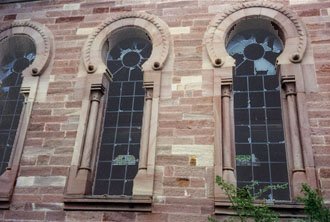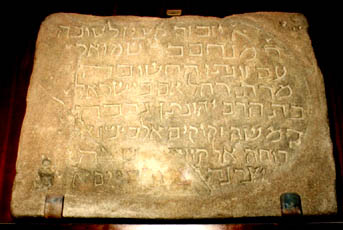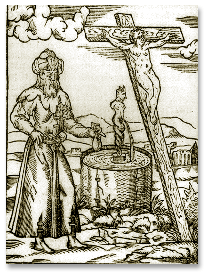in Alsace and Lorraine
 |
The familial and cultural heritage irrevocably disappeared in the provinces. Fortunately since 10-20 years non-profit organizations and regional cultural plans have been saving what still could be saved. In the last years politicians and culturally committed people became more and more aware that the Jewish heritage is undoubtedly an integral part of the general Alsatian history and partly of Lorraine. It is well known that the Alsatian Jewish community, mostly rural, was the biggest of whole France at the Revolution in 1789 and already differed from the Sephardim living in cities of southern France.
The Region of Alsace began for few years ago an annual project in order to rediscover the Jewish presence in this region thanks to a big cultural plan including guided visits, concerts, exhibitions, one-day bus tours of Jewish sites, Jewish meals in restaurants etc… The first aim of this project based on consensus is to create renewed interest in the Jewish specificity of Alsace, in fact to clear up misunderstandings and to dispel entrenched irrational fears.
All in all we get now more possibilities to get to know something about the Alsatian Jewish history and we will try to trace it now by relying on works and known authors in this field whom we will refer to in the bibliography below.
In a first place we will rapidly trace the history of the Jews of Alsace and Lorraine, which is often common to all Ashkenazim from Eastern France, Southern and Western Germany. In a second place we will look into specific aspects of the Alsatian and Lorraine Jewry. In a third place we will describe the Alsatian Yiddish.
Common history with all Jewish communities inside of the Roman Empire: Jewish laws from 417 under Christian emperors, continued by councils of the State Church.
Although formation of a specific, rather urban Jewish community of the Rhineland and intensive exchanges between the main centers.
No specific Jewish history in Alsace for this period. All Jews of the Frank Kingdom are foreigners under royal protection (Königsmunt). At that time Jews got their persistent image as usurers when the Church forbade loans with interests or pawn broking.
In a way there is here nothing specific for the history of the Alsatian Jews; they experienced the same advantages and especially the same inconveniences of a life in the Holy Roman Empire as all Jews scattered all over the territory. Thus the increase in the number of the seigneuries caused a big inequality between Jewries depending on whether the local lord was more or less benevolent to them or not! It must be admitted that the presence of Jews depended on the financial situation of the seigneurie; Jews were often there where they were needed.
It's the beginning of a period where the Jews came and went, were driven out and called back again. Nevertheless some Alsatian seigneuries differed from the majority because they protected "their" Jews over a longer period than it used to be at that time.
 |
Period of persecution and emigration.
In Alsace like in the whole Holy Roman Empire Jews belonged to the "befriedete" among clerics, women and storekeepers because they weren't allowed to carry a weapon; they weren't free and had to be protected. In 1236 under Friedrich II the Jews got the status of "chamber servants" (servi camerae nostrae) which was developed and codified by the Roman law as the servitude of the Jews : "servitus camerae" meant a personal and economical dependence on the emperor or his representatives. The Jewish community of Metz probably disappeared entirely in the 13th century.
In 1306 and 1394 Official expulsion of the Jews from France.
 |
In Metz the main urban Jewry disappeared already in the 13th century, a few households could be noticed but those who came back or settled down weren't assured that they could definitively stay. Though there was any official permission from the city authority, some Jews were tolerated. In the 14th century numerous Jews came from Eastern Europe to Metz and created there a ghetto near the port. The cohabitation between local Jews and East-European Jews was a little difficult because of different way of life and way of thinking.
In the dukedom Lorraine Jews experienced the same arbitrariness of the politics and their fate obviously depended on whether they were useful or not. They were alternatively driven out and called back, definitively expelled by duke René II in 1477 because they were accused to support the enemy (Burgundy). The next official permission for Jews to settle down in Lorraine happened only at the beginning of the 18th century.
So wherever we are looking, there was always a gap in the Jewish presence:
That doesn't mean that there weren't any Jews in these regions at all. But the main Jewish communities lived at that time in cities. They were there more visible and in a way more vulnerable! Few isolated Jews were scattered all over the region in the provinces, but it is obvious that there were numerically very few of the whole Jewish population in Alsace.
In Metz however
the situation changed abruptly when the city became French or under French
protectorate in 1552. Ten years later the Jews were officially allowed to
settle down in Metz again. It might be for many people very contradictory
regarding to the French attitude towards Jews in the main kingdom. But in
fact France needed Jews to finance the numerous regiments that were garrisoned
at Metz, known as the most fortified garrison town of France on foreign
soil and close to the Holy Roman Empire as its main enemy. The end justified
the means!
Moreover it was in the 16th century that the word "ghetto" for
Venetian "foundry" gave its name to all urban Jewish neighborhoods
in Europe, which were bordered and sealed off from the Christian parts.
Metz and Strasbourg
adopted this ghetto system and referred to pope Paul IV's ruling in 1555
ordering many discriminatory rules against Jews. Only 24 Jewish households
were allowed to live in Metz at that time.
About 160 families lived in villages in the 16th century in Alsace.
In a way Jews in Lorraine and Alsace were always in transit or on the alert.
It is important to stress the fact that the Alsatian Jewry progressively
changed from an urban community to a rural one for a very long period, that
means from the 14th to the 19th century. Those who were driven out from
the cities or left them by themselves found refuge in the provinces where
the local population took less notice of them than in the ghetto. There
were 2-3 families in each village.
On the contrary Metz has remained a center and a reference point for Jewish
life in Northern Lorraine such as Nancy
and Lunéville for southern Lorraine.
However a lot of Alsatian Jews definitively migrated to Germany, then Middle and Eastern Europe. In a way it is here a typical aspect of the Jewish history in Alsace, probably because it was a border region. There was a continual coming and going between West and East, right side and left side of the Rhine; everybody seemed to try his luck there where other people experienced injustice or misfortune. Adversity might be relative! Eastern European Jews came to Alsace and Metz and Alsatian Jews tried their luck in Poland or Lithuania.
| Next Page |
